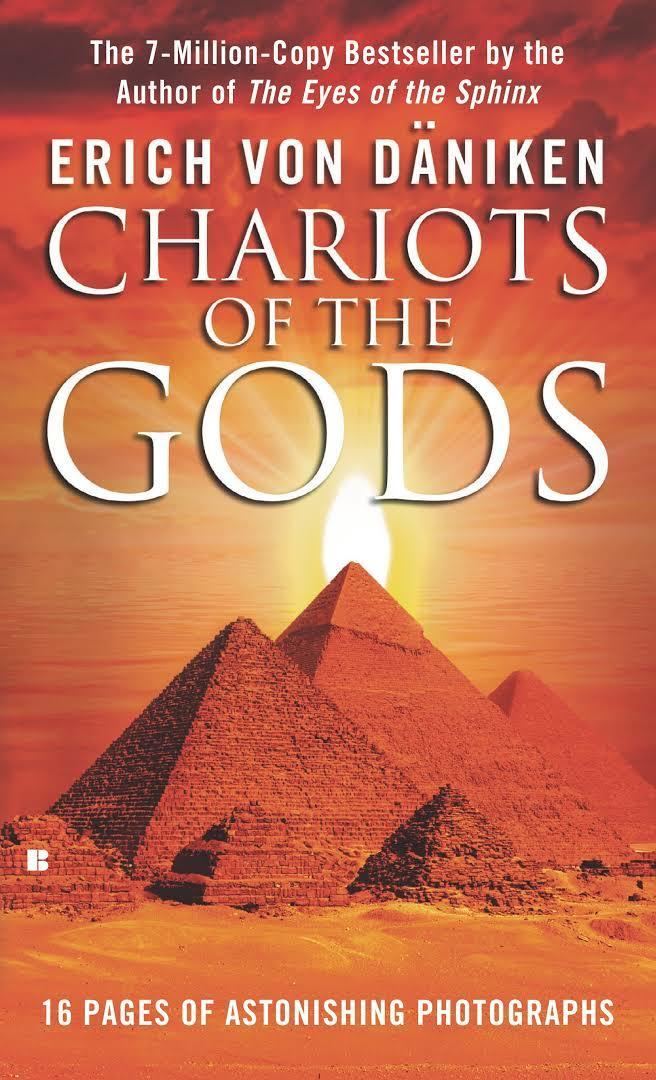7.4 /10 1 Votes
3.9/5 Barnes & Noble Language German Media type Print Genre Non-fiction | 3.5/5 Goodreads Country Germany Publication date 1968 Originally published 1968 Page count 267 | |||||||||||||||||||||||||||||||||
 | ||||||||||||||||||||||||||||||||||
Original title Erinnerungen an die Zukunft: Ungelöste Rätsel der Vergangenheit Publisher Econ-Verlag (Germany), Putnam (USA) Followed by The Eyes of the Sphinx: The Newest Evidence of Extraterrestial Contact in Ancient Egypt Similar Works by Erich von Däniken, Extraterrestrial life books, Non-fiction books | ||||||||||||||||||||||||||||||||||
Chariots of the Gods? Unsolved Mysteries of the Past (German: Erinnerungen an die Zukunft: Ungelöste Rätsel der Vergangenheit; in English, Memories of the Future: Unsolved Mysteries of the Past) is a book authored in 1968 by Erich von Däniken. It involves the hypothesis that the technologies and religions of many ancient civilizations were given to them by ancient astronauts who were welcomed as gods.
Contents
The first draft of the publication had been rejected by a variety of publishers. The book was extensively rewritten by its editor, Wilhelm Roggersdorf (a pen name of the German screenwriter Wilhelm "Utz" Utermann), Utermann had been a Nazi bestselling author and had held a leading position with the Völkischer Beobachter.
Overview
Von Däniken offers the following hypotheses:
Reception
Many scientists and historians have rejected his ideas, claiming that the book's conclusions were based on faulty, pseudoscientific evidence, some of which was later demonstrated to be fraudulent or fabricated, and under illogical premises. For example, Ronald Story wrote a book rebutting von Däniken's ideas in 1976 titled The Space Gods Revealed. A similar internationally bestselling book, titled Crash Go The Chariots by Clifford Wilson, appeared in 1972.
Soon after the publication of Chariots of the Gods?, von Däniken was accused of stealing the ideas of French author Robert Charroux.
A 2004 article in Skeptic magazine states that von Däniken plagiarized many of the book's concepts from The Morning of the Magicians, that this book in turn was heavily influenced by the Cthulhu Mythos, and that the core of the ancient astronaut theory originates in H. P. Lovecraft's short stories "The Call of Cthulhu" and "At the Mountains of Madness".
One artifact offered as evidence in the book has been disclaimed by von Däniken himself. Chariots asserts that a non-rusting iron pillar in India was evidence of extraterrestrial influence, but von Däniken admitted in a Playboy interview that the pillar was man-made and that as far as supporting his theories goes "we can forget about this iron thing." Neither this nor any other discredited evidence has been removed from subsequent editions of Chariots of the Gods.
One book commonly cited in support of von Däniken is The Spaceships of Ezekiel by former NASA design engineer Josef F. Blumrich (March 17, 1913 – February 10, 2002), who also wrote a summary article, "The spaceships of the prophet Ezekiel".
Legacy
The book was adapted as a German documentary film Chariots of the Gods, produced by Terra-Filmkunst, and as a TV documentary In Search of Ancient Astronauts (Alan Landsburg Productions).
As of March 2009, Paradox Entertainment owned the film rights of the book.
